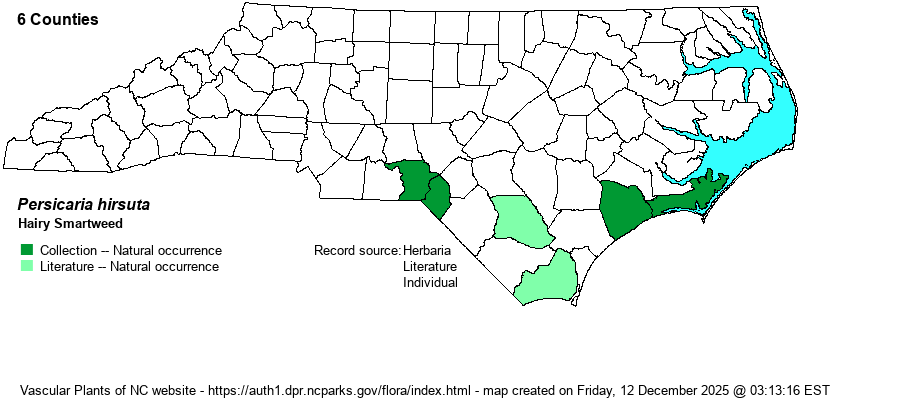| Author | (Walter) Small | |
| Distribution | Southern Coastal Plain and Sandhills (a single current population); ranges north only to Carteret, Onslow, and Richmond counties.
Coastal Plain, NC to central FL and southern MS. | |
| Abundance | Very rare to rare; scarce to rarely encountered. A population in Richmond County was feared lost until Loblolly Pines (Pinus taeda) were removed from the whole basin and a more normal water regime returned. Hundreds of plants now occur there. This is a State Endangered species. | |
| Habitat | Permanently to irregularly inundated ponds and depressions, usually in pinelands. Also "[White] Oak River, mucky bottom" in Onslow County. Unlike most others in the genus, it does not seem to occur in typical marshes and pond margins; it specializes in closed depression bays and ponds. |
| Phenology | Flowering and fruiting June-November, depending on water level. | |
| Identification | The generally densely, shaggy-hairy stems are unlike any of our other smartweeds. Stems may be erect, but often lazy and recline. They may poke up through shallow water, but do best when stranded. The leaves are narrow and mostly lanceolate; and the spike-like inflorescences are white to pale pink, rather densely-flowered. Even without flowers, this great rarity in NC is easily identified just by its densely hairy stems. As it occurs in bays and closed pools, it can occur with a few other rare wetland species. | |
| Taxonomic Comments | Often still named as Polygonum hirsutum.
Many species formerly treated in the genus Polygonum have been moved to Persicaria, the smartweeds. These are generally erect and tall plants with terminal and axillary floral spikes; most occur in wetlands. Others remain in Polygonum, the knotweeds, which are generally prostrate to ascending and with inconspicuous axillary flowers. They occur mostly in dry soils and tend to be weedy.
Attention must be paid to the small collars at the junction of the main stem and leaf stems (called ocreae) and whether they possess terminal hairs or bristles. Some keys also refer to the even smaller collars from which flowers emerge (called ocreolae). Another important ID character is the surface of the greenish sepals -- whether smooth or dotted with indentations (punctate). | |
| Other Common Name(s) | None | |
| State Rank | S1 | |
| Global Rank | G3G4 | |
| State Status | E | |
| US Status | | |
| USACE-agcp | OBL link |
| USACE-emp | OBL link |

